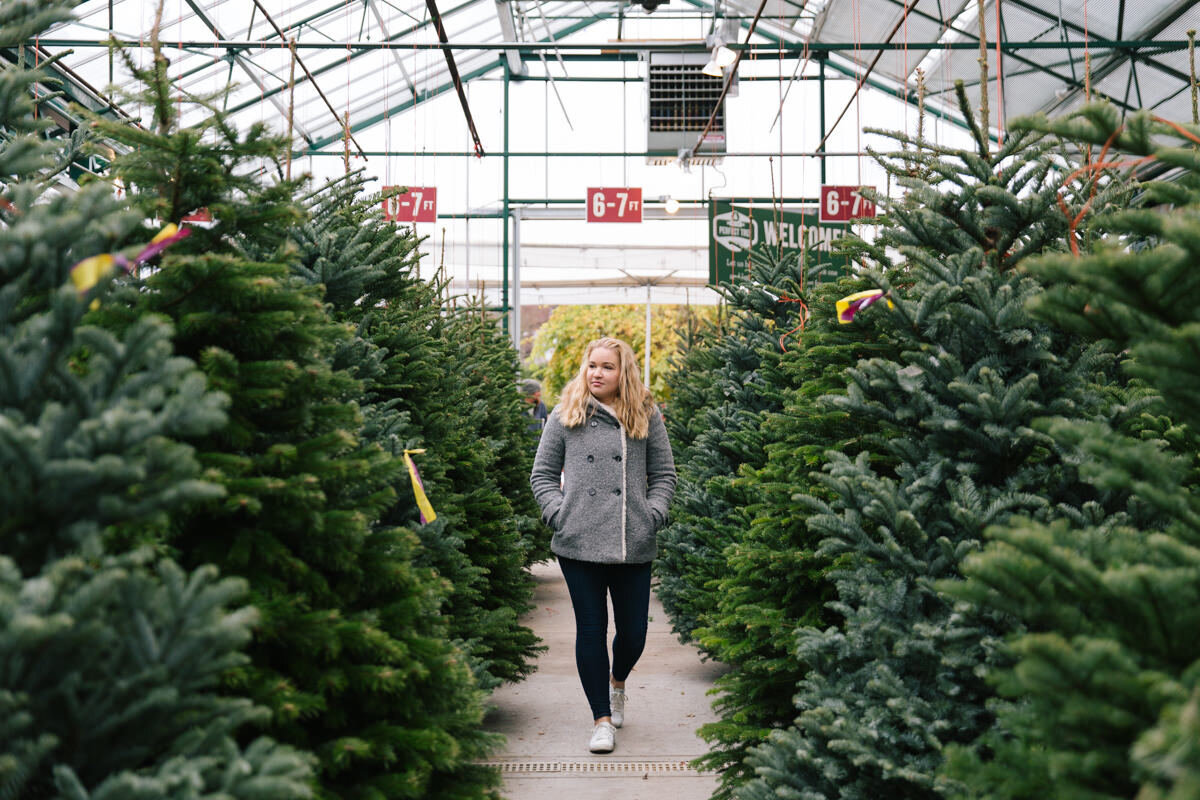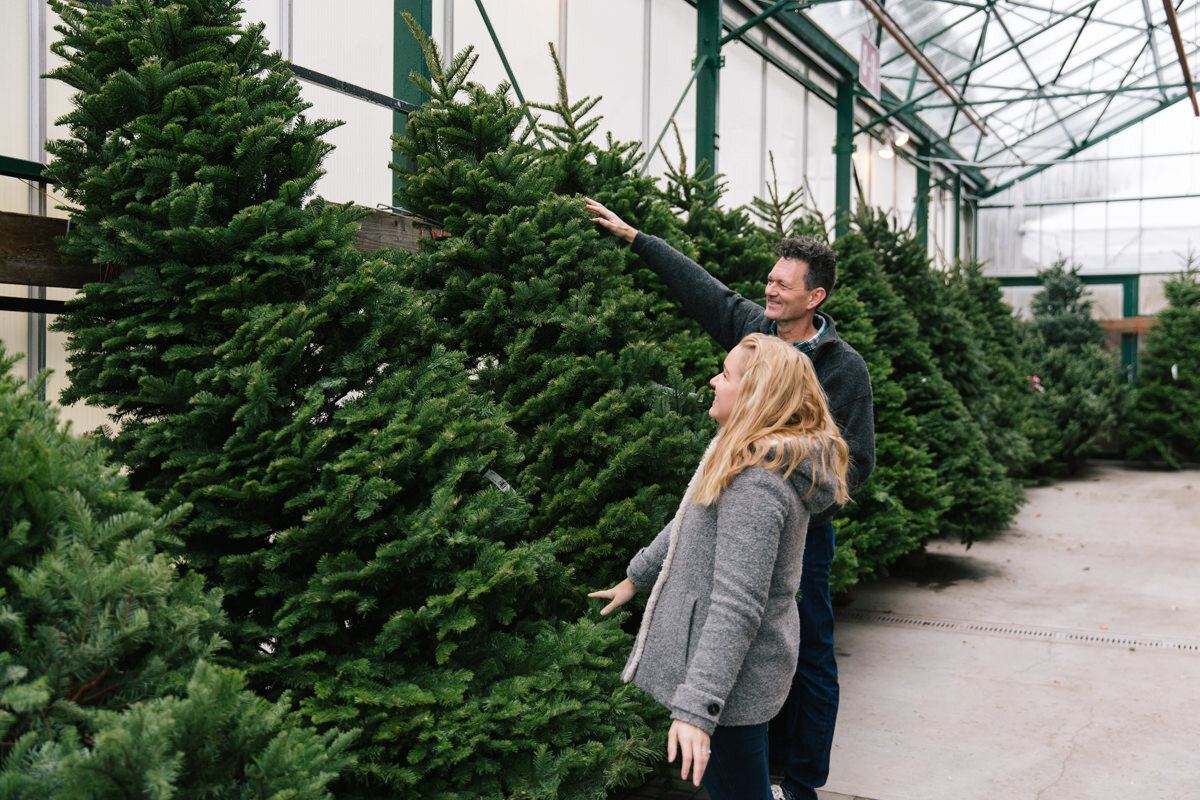Editor’s Note: This blog is a product of the collaboration between Swansons and Kirsten Dunn who writes Dunn Lumber’s Dunn DIY blog. We had a great time working with you, Kirsten! Thanks for choosing Swansons Nursery for your Christmas tree!
The holidays are here! This is my favorite time of year, and I can’t wait to start all of my holiday traditions—the most important one being getting a Christmas tree. The tree not only serves as the centerpiece of Christmas, choosing and decorating it is one of the most fun activities to do with the entire family. In Washington state, we’re lucky to have so many real forests surrounding us—which means we have some of the best trees to choose from. Finding that perfect tree can be overwhelming, so this year we’re getting some help. We assembled our most pressing Christmas tree questions and went to the experts.
We sat down with our friends at Swansons Nursery here in Seattle to create this guide with everything you’ve ever wanted to know about Christmas trees, plus a handy infographic! So, when it comes time to pick one out, you’ll know exactly which tree is best for you and your home.
Types of trees and tree densities
At Swansons, there are generally four varieties of trees sold: noble fir, Burton Blue (a unique type of noble fir exclusive to Swansons), Fraser fir, and Nordmann fir.
Within these four types of trees, there are three densities (as defined by Swansons) available: alpine, forest edge, and town square. It’s important to note that not every type of tree is available in each density (but more on that later!) Swansons works closely with their farmers to source more natural-shaped and open trees, so they’ll have that fresh-from-the-mountain look we love here in the Pacific Northwest. The alpine shape has the most open space between branches, giving it a modern, Scandinavian look; the forest edge shape has a slightly fuller silhouette; and the town square shape is the fullest of the three, making it more classic and traditional.
Deciding which tree is best for you
With proper watering, each of the four types of tree at Swansons will remain alive and beautiful for six to eight weeks before turning crunchy or losing their needles, so it will ultimately come down to which shape, aesthetic, or size you prefer when deciding which tree is best for you.
Each of the four types have their own unique look and feel to them—here’s how they compare:
Noble fir
The noble fir is the most popular choice of tree in the Pacific Northwest and is native to our mountains. They have that classic fir fragrance associated with Christmas trees that is sure to fill your home with memories of Christmases past. Noble firs are the sturdiest of the four types of trees listed and have horizontal branches; they have thick, green needles—with a slight bluish cast—that are more prickly than the other tree types. They’re available in all three densities, so you’ll be able to find a noble fir in whichever shape you prefer.
If you have heavy ornaments that need sturdy branches or want the classic Pacific Northwest tree in your home this Christmas, the noble fir is the one for you.
Burton Blue
The Burton Blue is the first named selection (or specific strand, named by the breeder) of noble fir, sold by the Burton family here in Washington. While regular noble firs have a hint of blue to them, Burton Blues are bred to be mostly bluish-silver in color (the color makes it look like there’s snow on the branches!). They have the same classic fir fragrance as noble firs, as well as thick needles and more horizontal branching. Burton Blues are only available in alpine and forest edge—so they’ll be more spacious in density and narrower in shape.
If you like the noble fir but want something a little more unique that’s sure to turn the heads of out-of-town friends and relatives, the Burton Blue is the tree for you.
Fraser fir
The Fraser fir is native to the East Coast mountains, making it the most popular choice of tree on that side of the country. Overall, Fraser firs have a narrower silhouette and are only available in the town square density. Their branches are strong and positioned upright, with a silvery underside to their blunt needles. In terms of scent, Fraser firs have a milder, sweeter fragrance compared to the other tree types.
If you live in a smaller home or apartment that requires a more compact tree, or if you want a tree reminiscent of the Rockefeller Center Christmas tree in New York City, the Fraser fir is the one for you.
Nordmann fir
The Nordmann fir is native to the European Caucasus Mountains and is the traditional German Christmas tree (or Tannenbaum), making it the most popular tree in Europe and most of the United States. They are the softest and fattest of the tree types listed here, and their “edges” are more rounded. Nordmann firs have flexible branches, with soft, glossy, dark green needles. They are available in the forest edge and town square density, and their scent is similar to the classic fir fragrance—but with a hint of citrus.
If you imagine a traditional, picturesque tree in your home, the Nordmann fir is the one for you.
Tree tips and tricks
Swansons is focused on providing the best tree-buying experience possible. Once you find your perfect tree, the Swansons staff will give it a fresh cut, put it in the “tree shaker” to shake off any dead needles, put the tree into the tree stand (if you want), and tie it to your car. While Swansons does all the hard work for you, there are some ways you can make the most out of your Christmas tree experience.
Shop early—and prep your home beforehand
To make the most of your time tree shopping and have as many options as possible, try to visit the nursery earlier in the holiday season rather than later. At Swansons specifically, weekdays are the least busy time to shop. Regardless of which tree you choose, if you water it consistently it should last six to eight weeks—so it’s sure to make it through the entirety of the holidays.
Before you leave your home to purchase a tree, take a moment to assess it and ask yourself these questions: How much space does my home have available for a tree? How tall is my ceiling? How wide is my door to get the tree inside? It's also helpful to lay a cloth or tree skirt on the floor where your tree will go and clear a walkway to bring your tree easily inside. And, of course, avoid placing your tree near a heater or fireplace as it will dry out your tree and affect its longevity (and potentially become a fire hazard).
Water it regularly
Once you have your tree in its place, remember it’ll be thirsty; your tree needs access to water. As soon as you bring your tree home, get it into water. The tree may take a few days to start soaking up water, but once it starts it will need consistent watering. The tree trunk should always be submerged.
Dispose of it properly
When you’re ready to take your tree out of your home after the holidays, make sure to dispose of it properly. The city of Seattle will pick up trees to compost into the first few weeks of January, or you can take your tree to a compost transfer center. If you have a backyard, you can use your tree for mulch or cut it into smaller sections for birds or critters to enjoy (if you’re comfortable with critters in your backyard, of course). See 6 ways to repurpose your tree.
Buying and decorating a Christmas tree is one of our favorite holiday activities. It brings our family together, and we get to make it our own! These trees are beautiful enough on their own, but making it even more special with lights and ornaments reminds us of why we do what we do here at Dunn Lumber—we take the ordinary and make it extraordinary. Regardless of which tree you choose for the holidays this year, it’s sure to be a beautiful addition to your home and will get you, your family, and your friends into the holiday spirit. Add some decorations to your tree with our DIY Christmas tree garland and our DIY Christmas tree collar, and don’t forget to add some holiday decorations to the outside of your home with our guide to hanging Christmas lights.






